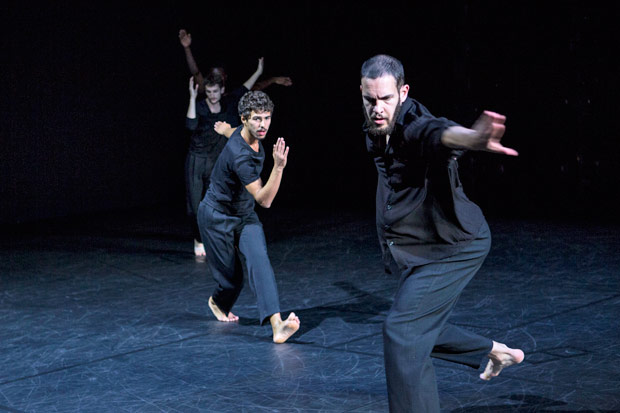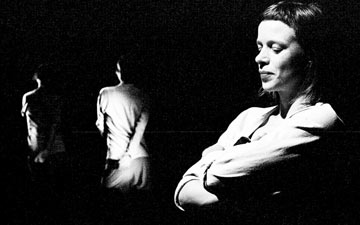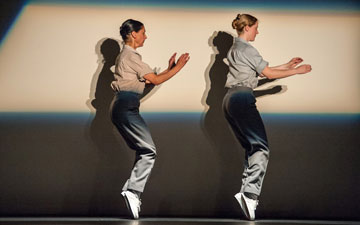
© Maria Baranova. (Click image for larger version)
Anne Teresa De Keersmaeker/Rosas with Salva Sanchis
A Love Supreme
★★★★✰
New York, New York Live Arts
27 September 2017
www.rosas.be
newyorklivearts.org
Soundwaves
Oh, Anne Teresa De Keersmaeker. What other choreographer can so doggedly drive a viewer to the verge of despair and then, almost casually, throw open the doors to ecstasy, all within the span of an hour? The Belgian choreographer certainly has a perverse streak, whether she is forcing the audience to listen to a violinist play a Bach partita in the dark or repeating a single movement phrase for fifteen minutes. And yet, her musical sensitivity is so refined and acute that at times one gets the impression that she is showing us the very essence of the music through movement. Few things produce such a visceral thrill.
This is especially so when the music in question is as great, and as complete as John Coltrane’s 1964 jazz album A Love Supreme, the basis of De Keersmaeker’s eponymous collaboration with the younger choreography Salva Sanchis, now playing at New York Live Arts. The two choreographers created the work together, originally in 2005, when Sanchis was a member of her company.
The album, a product of Coltrane’s spiritual awakening, was composed in a burst of creativity, recorded in a single take. The energy of the sound, of the players’ imagination and the mental force behind it, is extraordinary. It is the kind of album one wants to sit down and listen to with headphones on, following its logic from start to finish. And that is, more or less, what De Keersmaeker and Sanchis encourage the audience to do with their dance, to watch and listen and experience the music as if the notes and their reverberations were dancing before them.
The four dancers take on the profiles of the four original players: Coltrane on sax, McCoy Tyner on piano, Jimmy Garrison on bass, Elvin Jones on drums. (The original version from 2005 included men and women, but this new one, revised earlier this year, is all male.) The four men’s contrasting physiques and movement qualities add yet another dimension to our experience of the sound. Thomas Vantuycom is tall, brauny, heavy and lush, like Coltrane’s sax playing. Bilal El Had has the vivacity and mercurial quality of Tyner’s piano. Jason Respilieux is delicate, almost classical, sensitively recreating the reverberations of the double bass. José Paulo dos Santos ricochets and skitters across the ripple and flow of Jones’s drums. The rhythms come out of his head, his fingers, his feet.
We see the four men interacting, giving each other backup, seizing the melody or receding into counterpoint, improvising and expanding upon themes that run through the piece. Just as Coltrane’s musicians improvised within a strong, guiding structure, so do the dancers. From what De Keersmaeker and Sanchis have said, she was responsible for the overall architecture of the dance, while he developed the individual gestural themes: swishing arcs drawn with forearms and hands; deep squats on the downbeats; swinging legs and lunges; kicks, ripples, and slashing jumps. The energy is both masculine and delicate, sweaty and lyrical. In the final section, Coltrane’s “Psalm,” the four men form complex, tensile structures, lifting, pulling, supporting each other into human hieroglyphs. Throughout, they are in constant communication. At certain points they create oases of unison movement, giving the eye and the ear a rest.
This thrillingly unified musical gesture follows an opening section in which, after a silent introduction, a single dancer (Vantuycom), faces the audience for what feels like an eternity, doing almost nothing. In reality, it lasts only ten or fifteen minutes. But whatever the purpose of the exercise, it feels superfluous and unnecessarily trying. As soon as the music begins, and the other three men rush on, a wave of relief and pleasure washes over the audience.
Perhaps the purpose of the long wait – a typical De Keersmaeker torment – is precisely this: to intensify the rush of what follows.

















You must be logged in to post a comment.